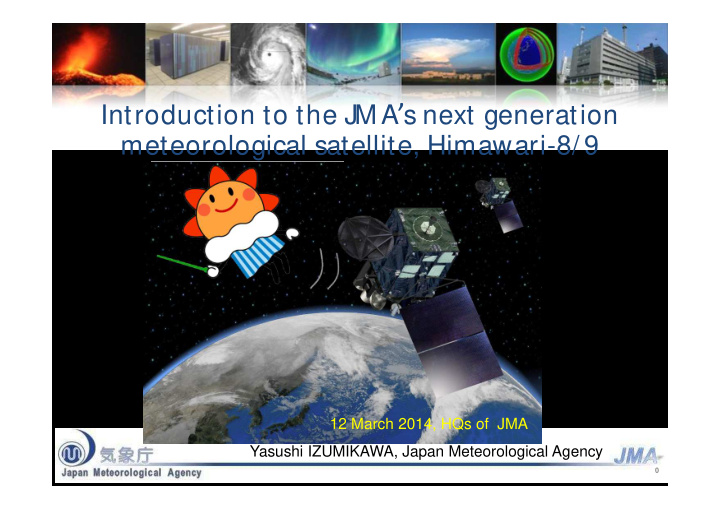



Introduction to the JMA ’ s next generation meteorological satellite, Himawari-8/ 9 M asanori OBAY ASHI Satellite Program Division 12 March 2014, HQs of JMA Observations Department J M A Yasushi IZUMIKAWA, Japan Meteorological Agency 0
Transition of Operational Satellites 2005 2006 2007 2008 2009 2010 2011 2012 2013 2014 2015 2016 2017 2018 2019 2020 2021 2022 2023 2024 2025 2026 2027 2028 2029 MTS AT-1R Operational In-orbit standby Meteorological Mission MTS AT-2 Operational In-orbit standby In-orbit standby Meteorological Mission Launch Operational In-orbit standby Himawari-8 Manufacturing Launch In-orbit standby Operational Himawari-9 JMA plans to launch Himawari-8 in 2014 and begin its operation in 2015 . The launch of Himawari-9 for in-orbit standby is scheduled in 2016 . Himawari-8/ 9 will be in operation around 140 degrees East covering the East Asia and Western Pacific regions for 15 years. 1
Himawari-8/ 9: Specification of Observation Channels of the Advanced Himawari Imager (AHI) Central Wavelength Spatial Channel [ μ m] Resolution 0.43 – 0.48 1 1 km RGB Composite 0.50 – 0.52 2 1 km True Color Image 0.63 – 0.66 3 0.5 km 0.85 – 0.87 4 1 km 1.60 – 1.62 5 2 km 2.25 – 2.27 6 2 km 3.74 – 3.96 7 2 km 6.06 – 6.43 8 2 km Water 6.89 – 7.01 9 2 km Vapor Full disk 7.26 – 7.43 10 2 km Interval: 10 minutes (6 times per hour) SO 2 8.44 – 8.76 11 2 km Japan area O 3 9.54 – 9.72 12 2 km Interval: 2.5 minutes (4 times in 10 minutes) 10.3 – 10.6 13 2 km Dimension: EW x NS: 2000 x 1000 km x 2 Atmospheric 11.1 – 11.3 14 2 km Windows Target area 12.2 – 12.5 15 2 km Interval: 2.5 minutes (4 times in 10 minutes) Dimension: EW x NS: 1000 x 1000 km CO 2 13.2 – 13.4 16 2 km Number of Channels: 5 16 Interval: 30/60 min. 10min. 2
M SC Web Page for Himawari-8/ 9 Information MSC website top page http://mscweb.kishou.go.jp/ Details of AHI 3
Himawari-8/ 9: Data Distribution/ Dissemination New equipment needs Himawari-8/ 9 Communication Satellite (CS) to be installed . HRIT files, … raw data (TBD) C-band antenna C-band (4 GHz) DVB-S2 (b) CS Operator LNB Internet (a) Service DVB-S2 Internet receiver J M A Users All imagery (full resolution data) PC & Main Target software (a) Internet Service : National Meteorological and Hydrological Services (NMHSs) (b) CS : NMHSs with limited Internet connection You can freely re-distribute/re-disseminate both data you receive. 4
Schedule of Distribution/ Dissemination 2012 2013 2014 2015 2016 Operation of Satellites MTSAT-1R In-orbit standby M eteorological M ission MTSAT-2 Operational In-orbit standby M eteorological M ission Launch Operational Manufacturing Himawari-8 Launch Himawari-9 Imagery Distribution/Dissemination via MTSAT Operational (direct) (MTSAT-2 imagery) via the Test Operational Internet (Himawari-8 imagery) (Himawari-8 imagery) Operational Operational via a CS (MTSAT-2 imagery) (Himawari-8 imagery) JMA will announce the details of CS (to be fixed in May 2014) and its receiving equipment in the spring of 2014. Parallel dissemination is planned to ensure users ’ smooth transition to receive imagery via a CS. 5
Internet service Format Observation Note T entative! Area Himawari Standard Full Disk - Full Disk: Every 10 minutes Data Target Area - Target Area: Every 2.5 minutes - 16 bands - The finest spatial resolution data Portable Network Full Disk - True-color images compositing 3 visible bands Graphics (PNG) Target Area - Full Disk: Every 10 minutes - Target Area: Every 2.5 minutes - Same spatial resolution as Himawari Standard Data Network Common Target Area - Every 2.5 minutes Data Form (NetCDF) - 16 bands - Same spatial resolution as Himawari Standard Data - Compatible format as current MTSAT series ’ HRIT HRIT files Full Disk service - Every 10 minutes - 5 bands (VIS: 1 band, IR: 4 bands) - Coarser spatial resolution than Himawari Standard Data Tentative data set to be distributed via the Internet service. • Basically one download per one nation • Registration for account is required • No special equipment is needed but high-speed Internet connection is required 6
CS dissemination T entative! Data type Format Note - Similar to current MTSAT series ’ HRIT and LRIT Himawari-8/9 Imagery HRIT files LRIT files services - Every 10 minutes - HRIT: 5 bands (VIS: 1 band, IR: 4 bands) - LRIT: 3 bands (VIS: 1 band, IR: 2 bands) - Products of JMA ’ s Global Spectrum Model (GSM) Numerical Weather SATAID Prediction Products (GPV) format - Every 6 hours In-situ Observations SATAID - Collected observation data from the East Asia (Surface stations, ships, format and Western Pacific regions radiosondes) ASCAT SATAID - Originally provided by EUMETSAT Ocean and Ocean Surface Wind format Sea Ice Satellite Application Facility (OSI SAF), (EUMETSAT) and converted into SATAID format by JMA Tentative data set to be disseminated via a communication satellite. • No registration required • Some equipment and receiving software are required 7
Sample screenshots of SATAID 8
Contact point for Distribution/ Dissemination Yasushi Izumikawa (Mr) E-mail: metsat@met.kishou.go.jp Phone: +81-3-3201-8677 FAX: +81-3-3217-1036 9
Thank You for your attention. 10
M ain feature of Himawari Standard Data/ HRIT Himawari Standard Data HRIT (light set of Himawari-8/ 9 data) (full set of Himawari-8/ 9 data) From Internet service From Communication satellite dissemination, Internet service There is no standard viewer. User must There are some viewers for HRIT data. prepare their own processing module for operation. Recommended for product developers Recommended for weather forecasters 11
Recommend
More recommend